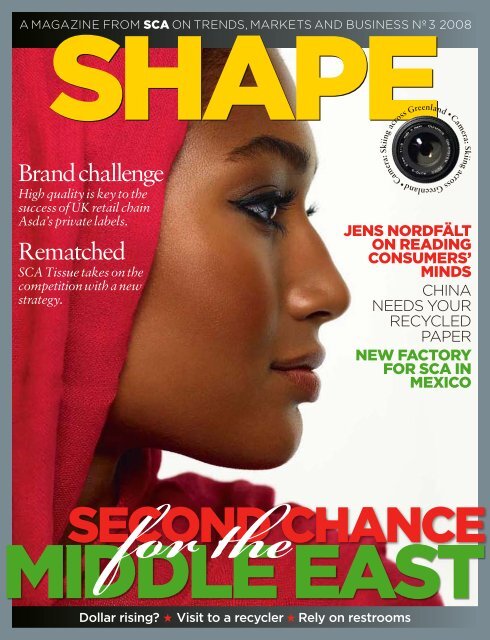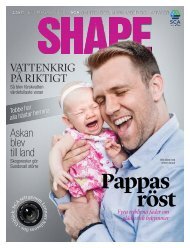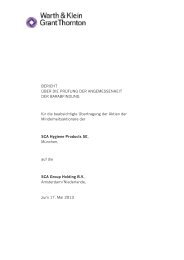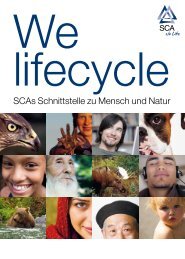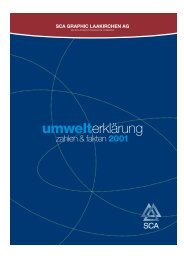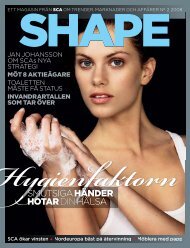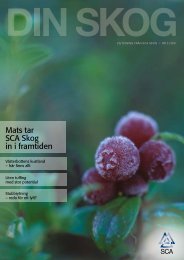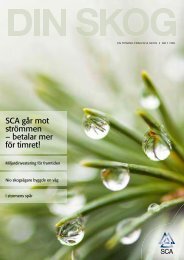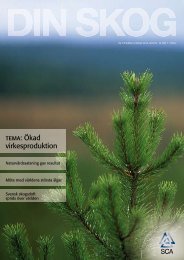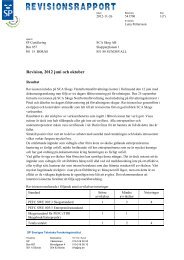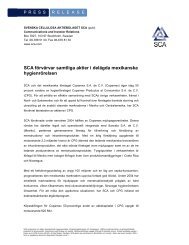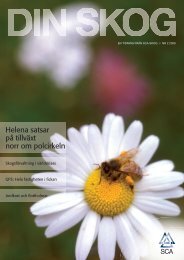Create successful ePaper yourself
Turn your PDF publications into a flip-book with our unique Google optimized e-Paper software.
Brand challenge<br />
High quality is key to the<br />
success of UK retail chain<br />
Asda’s private labels.<br />
Rematched<br />
<strong>SCA</strong> Tissue takes on the<br />
competition with a new<br />
strategy.<br />
for the<br />
<br />
<br />
<br />
<br />
<br />
<br />
<br />
<br />
<br />
<br />
<br />
<br />
Camera: Skiing across Greenland <br />
<br />
<br />
Camera: Skiing across Greenland
Contents Nº 3 2008<br />
<br />
<br />
<br />
<br />
6
20<br />
22<br />
30<br />
23<br />
<br />
<br />
<br />
<br />
<br />
<br />
<br />
Last year saw a new world record in recycling.<br />
Better hand hygiene would improve school attendance.<br />
More short news on the Shape Up pages.<br />
<br />
The Middle East may be the world’s next big<br />
growth market. If these countries play their cards<br />
right, the region has the chance to become a major<br />
player in the global market.<br />
<br />
China is consuming more paper products than ever<br />
before and is gobbling up recovered paper in the<br />
world market. Follow as well the journey of recycled<br />
paper through a recovered paper plant.<br />
<br />
China’s one-child policy has meant there are<br />
too few people to care for the aging population.<br />
Now the government is building nursing homes.<br />
<br />
Jens Nordfält has analyzed the way we like to walk<br />
through stores, and he knows the strategies for how<br />
to sell more.<br />
<br />
With a new sharper strategy <strong>SCA</strong> will be<br />
No. 1 in branded tissue products.<br />
<br />
<strong>SCA</strong>’s Claes-Göran Erson skied 1,500 km across<br />
Greenland’s glaciers to the northernmost point of<br />
mainland in the world.<br />
<br />
The darkening clouds of the financial crisis are<br />
casting a shadow over the global economy.
3,5<br />
3,0<br />
2,5<br />
2,0<br />
1,5<br />
1,0<br />
0,5<br />
0,0<br />
<br />
<br />
<br />
<br />
<br />
<br />
<br />
<br />
<br />
<br />
<br />
<br />
<br />
<br />
<br />
<br />
<br />
<br />
<br />
Nearly 22 million school days<br />
are lost each year to the common<br />
cold alone in the US.<br />
However, students who<br />
frequently wash their hands miss<br />
fewer days than students with<br />
poor hand hygiene.<br />
<br />
<br />
<br />
<br />
<br />
<br />
<br />
<br />
<br />
<br />
<br />
<br />
<br />
<br />
<br />
<br />
<br />
<br />
<br />
<br />
Did you know...
Unclean bathrooms scare away<br />
restaurant guests
For decades, the Middle East has often been<br />
associated with conflicts and with poverty in sharp<br />
contrast with a wealthy few. But in the wake of the<br />
latest oil boom, the region has the opportunity of a<br />
lifetime to lift itself up into the elite ranks of the<br />
global economy.<br />
<br />
n the mid-1950s, Qatar was a<br />
tiny, dusty country populated<br />
by nomads and fishermen. The<br />
level of education was low,<br />
even by the extremely low standards<br />
of the time. There were<br />
no navigable roads and not a<br />
single school in the entire country.<br />
Today the Gulf state is the richest<br />
country in the world, knocking Luxembourg<br />
from that position with a per<br />
capita GNP of more than $80,000.<br />
On the outskirts of the capital Doha,<br />
the futuristic buildings of “Education<br />
City” now cover 14 square kilometers.<br />
The complex is a knowledge and education<br />
center that is home to some of the<br />
leading university departments in the<br />
Arab world, including branches of five<br />
top American universities.<br />
Record-high prices for fossil fuels<br />
in recent years have created a regional<br />
boom in oil-rich Gulf states like Qatar,<br />
the United Arab Emirates and Bahrain.<br />
Up to this point, it could have been a<br />
replay of the oil boom of the 1970s and<br />
‘80s. Back then, this newfound wealth<br />
produced as much misery as happiness.<br />
The money was squandered on<br />
private fleets of Rolls-Royces with all<br />
the extras, lost at the gambling tables<br />
of Monte Carlo or parked in Swiss bank<br />
accounts.<br />
The money cemented the power of<br />
authoritarian leaders and their relatives<br />
and made modernization and reforms
less urgent. When oil prices fell in the<br />
1990s, the region was hit by an economic<br />
hangover that created a breeding ground<br />
for discontent and conflicts.<br />
skyrocketing oil prices,<br />
the region now has a second chance.<br />
“We’re standing on the brink of a new<br />
Middle East – young, entrepreneurial<br />
and strong,” says a confident Khaldoon<br />
Al Mubarak, CEO of Mubadala Development<br />
Company in the United Arab<br />
Emirates, in conjunction with a World<br />
Economic Forum on the Middle East<br />
last summer.<br />
Kenneth Pollack of the US-based<br />
Brookings Institution’s Saban Center<br />
for Middle East Policy agrees, up to a<br />
point. “The economic boom is creating<br />
opportunities to address basic political,<br />
economic and social problems that<br />
have given rise to terrorist groups like<br />
al-Qaeda,” Pollack says. “There’s just a<br />
<br />
risk that this wealth will produce more<br />
problems than it solves.”<br />
Economic booms, peak prices for<br />
food and raw materials and a number<br />
of currencies tied to the dollar have accelerated<br />
inflation – a development that<br />
has hit broad groups of low -and middle-income<br />
earners hard. “Nowadays,<br />
we have to choose either to keep warm<br />
or have enough to eat,” Abdul Rahmna,<br />
a clothing salesman in Amman, Jordan,<br />
told the New York Times. “We’re not<br />
middle class anymore. We’re living on<br />
the edge of poverty.”<br />
Despite considerable investment in<br />
education, major resources are needed<br />
to meet the other big challenge in the region:<br />
the enormous share of unemployed<br />
young people in the local population.<br />
According to the McKinsey consulting<br />
firm, the Gulf states must create<br />
280,000 jobs a year to employ all the<br />
young people graduating from schools
and universities over the next few years.<br />
So a number of countries, such as Oman,<br />
are trying to replace the foreign workers<br />
in the region with domestic labor. This<br />
is not easy task, given that most employers<br />
have learned to appreciate foreign<br />
workers, who are cheap, highly motivated<br />
and often well educated.<br />
The easy oil riches in the region and an<br />
emphasis on family connections rather<br />
than qualifications have produced a large<br />
group of young Arabs with a lackadaisical<br />
attitude toward work. Yet despite difficult<br />
challenges and what is still an uneven<br />
income distribution, there are many<br />
positive signs.<br />
Across the entire region, even beyond<br />
the oil states, median incomes have al-<br />
most doubled in recent years. A middle<br />
class with purchasing power is on the<br />
rise. Auto sales in populous Egypt, for<br />
instance, have quadrupled in just a few<br />
years.<br />
of all, many of the<br />
countries seem to be taking steps toward<br />
a future beyond the oil billions that have<br />
been so easy to come by.<br />
In the last few years, millions of visitors<br />
to Dubai have gaped at the architectural<br />
extravagance in this corner of<br />
the United Arab Emirates. In the midst<br />
of desert sands stand the world’s tallest<br />
building, Burj Dubai, three of the tallest<br />
hotels, the world’s only seven-star hotel<br />
and the indoor ski resort Ski Dubai.
The odd thing about these feats is<br />
that only 3 percent of Dubai’s income is<br />
derived from oil and gas, with the bulk<br />
coming instead from trade, transportation,<br />
financial services and tourism.<br />
The economic boom and reforms<br />
have created hope not just among the<br />
Arab world’s own inhabitants but also in<br />
boardrooms far from the desert sands.<br />
During a difficult summer for the<br />
global aviation industry, Dubai’s neighbor,<br />
Abu Dhabi, accounted for one of<br />
the few positive bits of news when its<br />
national airline placed the largest aircraft<br />
order in recent years, totaling $43<br />
billion, with the American company<br />
Boeing and the European consortium<br />
Airbus.<br />
For a financial industry squeezed<br />
hard by the US subprime mortgage crisis,<br />
these homeless oil billions provide<br />
a guarantee of continued liquidity. “At<br />
the same time, the money has found its<br />
way back home and is now being used<br />
for investments in these countries instead<br />
of in the West,” says Marcus Wenestam<br />
at the Swedish Trade Council in<br />
Saudi Arabia.<br />
“The Arab world is developing and<br />
is finally on its way to becoming part of<br />
the globalization,” says Fadi Ghandour,<br />
chairman of the Jordanian transportation<br />
group Aramex International, in<br />
conjunction with the World Economic<br />
Forum.<br />
This comes as a relief not just for the<br />
region’s inhabitants but also for the rest<br />
of the world. A stable, flourishing Middle<br />
East is the best way to overcome<br />
the conditions that have produced<br />
a breeding ground for the terrorism<br />
that has long plagued the region.
Tempo Complete Care<br />
my secret remedy during a cold<br />
NEW – Tempo Complete Care with its unique<br />
combination of breath-free oils and pampering<br />
balm, soothes the nose and lets you breathe freely.
Tempo Complete Care<br />
my secret remedy during a cold<br />
NEW – Tempo Complete Care with its unique<br />
combination of breath-free oils and pampering<br />
balm, soothes the nose and lets you breathe freely.
<strong>SCA</strong> sells sanitary protection in the Middle East,<br />
one of the hottest markets in the world but also<br />
difficult to navigate. For clever and courageous<br />
players, there are enormous opportunities.<br />
<br />
the<br />
Middle East is the most dynamic market<br />
in the world and it’s at the top in growth<br />
in purchasing power, although in many<br />
cases that is still unevenly distributed,”<br />
says Peter Dahlqvist, who is responsible<br />
for <strong>SCA</strong>’s efforts in the region.<br />
Last fall, <strong>SCA</strong> began collaborating<br />
on a joint venture with its local partner<br />
Nuqul in Jordan. The new company<br />
will manufacture and sell sanitary protection<br />
in 18 countries in the region.<br />
“The strict religious traditions in<br />
countries like Saudi Arabia can be a<br />
<br />
<br />
<br />
<br />
<br />
<br />
<br />
<br />
<br />
<br />
<br />
<br />
<br />
<br />
<br />
<br />
<br />
<br />
<br />
<br />
<br />
<br />
<br />
<br />
<br />
<br />
<br />
challenge, for example, when you want<br />
to market products,” Dahlqvist says.<br />
“The taboos there relating to menstruation<br />
make it extremely important that<br />
women keep it concealed, which means<br />
women consumers choose quality when<br />
they buy sanitary protection.<br />
“There are many reasons for <strong>SCA</strong>’s<br />
investment in the Middle East. In consumer<br />
goods and the retail industry, the<br />
demographics are a strong driving force<br />
in regions that has large families. In<br />
Saudi Arabia, 38 percent of the population<br />
is under 15.
“Even though the country has only<br />
one-third the population of Germany,<br />
there are more children in Saudi Arabia,”<br />
Dahlqvist says. “That creates a<br />
big market for diapers today, and in the<br />
next few years demand for menstruation<br />
protection will increase.” ”In the past,<br />
the wealth from the oil was unevenly distributed,<br />
and the wake of the resulting<br />
discontent has caused instability in the<br />
region. Paradoxically, this is putting pressure<br />
on the oil princes today to spread the<br />
economic well-being, he explains.<br />
“A growing, flourishing middle<br />
class is in fact often the basis for stable<br />
growth,” Dahlqvist says, pointing to<br />
countries such as Tunisia, Jordan and<br />
the United Arab Emirates.<br />
The turbulent political situation has<br />
kept many players out of the region. But<br />
today the trend is starting to turn. For<br />
instance, the French retailer Carrefour<br />
is investing heavily in the region.<br />
“As for <strong>SCA</strong>, it means we can be in<br />
a market that has really strong growth<br />
<br />
<br />
<br />
<br />
<br />
<br />
<br />
<br />
<br />
<br />
<br />
<br />
<br />
<br />
<br />
<br />
<br />
<br />
<br />
<br />
potential early on,” Dahlqvist says.<br />
“Procter & Gamble is the only one of<br />
our global competitors to set up operations<br />
here.<br />
“It’s often an advantage in today’s<br />
polarized global politics to be a European<br />
company in the region, although<br />
our Danish neighbors have seen how<br />
quickly things can change.”
Skicka kupongen portofritt i ett kuvert märkt ”FRISVAR”<br />
till: <strong>SCA</strong> Packaging, 0020192361, 331 20 Värnamo.<br />
Märk kuvertet ”Säljklart”. Eller faxa telefon 0370 193 29.<br />
<strong>SCA</strong> PACKAGING SWEDEN AB<br />
www.scapackaging.se<br />
Dina förpackningar kningar<br />
kan bli morgondagens ondagens<br />
säljare<br />
Att exponera är att sälja.<br />
Men exponering kräver tid och personal.<br />
Lösningen ligger i bättre förpackningar<br />
som klarar hela kedjan från producent<br />
till butikshylla. Några enkla handgrepp<br />
och dina varor ligger väl synliga och<br />
lätta att plocka.<br />
Direkt ur en Säljklar förpackning.<br />
Namn<br />
Befattning<br />
Företag<br />
Adress<br />
Postadress<br />
Tel.<br />
Mail<br />
Kontakta mig för en beskrivning av vad ni kan<br />
inom ämnet ”Säljklara förpackningar”.<br />
Jag har ett aktuellt projekt. Ring direkt.<br />
<br />
<br />
<br />
<br />
<br />
<br />
✃
Rising<br />
<br />
stars <br />
Private labels have come a long way from being<br />
just plain-wrapped, low-priced options. Thanks to<br />
product innovation and better-than-the-leadingbrand<br />
quality, they now outsell branded goods in<br />
many categories.<br />
<br />
the world are<br />
investing more and more in their own<br />
brands. The concept of private labels<br />
has changed dramatically over the past<br />
five to 10 years, while sales have shot up.<br />
At Asda, Britain’s second-largest retailer,<br />
private labels now make up a large<br />
percentage of total sales of both edible<br />
and non-edible products.<br />
Len Barker, general manager of nonedible<br />
grocery and baby products at<br />
Asda, confirms that consumer attitudes<br />
toward private labels have changed dramatically.<br />
“Private labels used to be seen as a<br />
cheap and cheerful option, though not as<br />
good as the brand leader,” he says. “Today<br />
people expect a private label to have a<br />
very good quality base and to be as good<br />
as, or better than, the leading brand.”<br />
Private labels started out several decades<br />
ago as anonymous products at the<br />
low end of the price range. But now store<br />
brands form an entire brand architecture<br />
in their own right, often covering at<br />
least three segments of the price range –<br />
cheap, standard and premium. They also<br />
include specialty lines such as organi-<br />
<br />
g <br />
cally produced goods and eco-labeled or<br />
fair-trade-certified products.<br />
Uncertainty about the economy<br />
makes price a greater concern for shoppers,<br />
and private labels in general have<br />
become more aggressive, Barker says.<br />
“We are entering a period of six to 18<br />
very interesting months,” he says. “The<br />
economic climate is getting tougher, and<br />
people still have to eat. If things continue<br />
to get tougher, they might be more and<br />
more inclined to ditch branded products<br />
in some low-involvement categories,<br />
particularly in such a mature market as<br />
the UK.”<br />
problems in selling<br />
branded goods next to private labels, as<br />
its strategy is based entirely on what the<br />
consumer wants.<br />
“It’s all about giving the consumers<br />
the benefit of choice,” Barker says.<br />
“They have to be happy with what<br />
they’re buying from us. By voting with<br />
their feet, they tell us what they want or<br />
don’t want.”<br />
The relationship between branded<br />
products and private labels on Asda<br />
<br />
<br />
<br />
<br />
<br />
<br />
<br />
<br />
<br />
<br />
<br />
<br />
<br />
<br />
<br />
<br />
<br />
<br />
<br />
<br />
<br />
<br />
<br />
<br />
<br />
<br />
shelves varies across categories, Barker<br />
says. In some categories, private label<br />
penetration is relatively low.<br />
“Washing powder, for example, is<br />
dominated by a handful of very big<br />
multinational brands, so Asda private<br />
labels have a slightly different role,” he<br />
says. “Because laundry is so heavily advertised<br />
and constantly pushed, many<br />
customers still hold the idea that private<br />
labels are never going to be as good.”<br />
In the tissue category, on the other<br />
hand, private labels play a bigger role at<br />
Asda, whose strategy is to come up with<br />
products that are better than the leading<br />
brand. One highly successful result is Asda<br />
Shades, a private label toilet tissue supplied<br />
by <strong>SCA</strong>.<br />
“We have got a fairly unique proposition<br />
versus most of our competition.<br />
“It is one of our few private labels that<br />
have outsold the biggest brand by a long<br />
way for many years. We refer to Shades<br />
as ‘the crown jewel’ among our private<br />
labels.”<br />
general strategy<br />
behind its own brands is to gener-
ate a “very credible option.” Trying to<br />
push inferior products under a private<br />
label could damage the overall brand,<br />
he warns.<br />
“We have to make sure that we are<br />
not giving anyone any reason to complain<br />
about quality in anything that we<br />
put our name on,” he says. “We have<br />
a reputation to keep, and the entire<br />
Asda brand might suffer from poor<br />
performance from an Asda-labeled<br />
product.”<br />
While Asda has been owned by Wal-<br />
Mart, America’s No. 1 discount retailer,<br />
since 1999, it has a long heritage<br />
as a value retailer in Britain, Barker<br />
says. The idea, he says, is “great-quality<br />
products at great prices, not poorquality<br />
products at cheap prices.”<br />
In the absence of the massive advertising<br />
and promotion employed by<br />
global brands, private labels have to<br />
use packaging as a means of communicating<br />
with the customer, and they<br />
must also show more creativity and<br />
be faster to market with innovations,<br />
Barker says.<br />
that as consumers have<br />
become savvier, less advertising might<br />
even work in favor of customer perception.<br />
“I think people have become more<br />
aware of the fact that a lot of the price<br />
difference between branded goods and<br />
private labels is related to advertising,”<br />
Barker says. “And we try to do things<br />
with our brands that even the leading<br />
brand has not done. Asda Shades being<br />
first to market with sustainability<br />
FSC labeling is one example.”<br />
Barker says what he really wants<br />
from a private label supplier is that it<br />
helps Asda stand out from the crowd<br />
<br />
<br />
<br />
<br />
<br />
<br />
<br />
<br />
by offering a unique point of difference<br />
versus the competition.<br />
“We need products that are first to<br />
market, and the supplier must be able<br />
to cover everything, including environmental<br />
benefits,” he says.<br />
In general, Barker finds relationships<br />
with private label suppliers to be<br />
different from relations with branded<br />
product manufacturers.<br />
“They have to be,” he says. “Generally<br />
speaking, there is a difference in<br />
attitude. With a big branded supplier,<br />
their priority is their brand on our<br />
shelves and not our customer.”<br />
The offerings of branded suppliers<br />
might not be ideal for Asda shoppers,<br />
whether in terms of pack size, quality,<br />
flavor or pricing, he says.<br />
What about the future, then – will<br />
private labels take over the shelves<br />
completely?<br />
“If the customer wants it, why not?”<br />
Barker concludes.
Recovered paper is in big demand. China’s growing<br />
economy is short of raw materials including<br />
wood fiber. Demand for recovered paper is expected<br />
to remain high for the foreseeable future, keeping<br />
upward pressure on prices and leading to a<br />
global shortage in the recovered paper market.<br />
<br />
The fiber cycle<br />
growth in recent<br />
years has created enormous demand for<br />
all types of paper products and for raw<br />
material in the form of recovered paper.<br />
“As prosperity rises in China and elsewhere<br />
in Asia, more and more people<br />
are beginning to use tissue products and<br />
read newspapers,” says David Knight,<br />
director of <strong>SCA</strong> Fiber Procurement in<br />
North America. “The increase in consumption<br />
also means that the demand<br />
for cardboard and packaging is growing<br />
considerably.”<br />
Over the next two years, the global<br />
market for recovered paper is expected<br />
to grow by 20 million tons from the 200<br />
million tons of recovered paper converted<br />
globally in 2007. To meet this<br />
increased demand, the industry faces a<br />
number of challenges. “Above all, we<br />
need to recycle more paper,” Knight<br />
says. In Europe, the recycling rate is<br />
about 63-64 percent. The best countries<br />
are Sweden, Germany, the Netherlands,<br />
Austria and Switzerland, which<br />
all have rates over 70 percent. Japan is<br />
<br />
also up there with 65-70 percent. In the<br />
US, however, the recycling rate is only<br />
53 percent.<br />
reached the same recycling<br />
rate as the European average, it would<br />
mean another 10 million tons a year,<br />
which is absolutely necessary to meet<br />
the demand from China,” says Hans<br />
<br />
<br />
<br />
<br />
<br />
<br />
<br />
<br />
<br />
<br />
Wortman, managing director of the<br />
European-based <strong>SCA</strong> Recycling.<br />
The markets for recovered paper in<br />
the US and Europe differ in one important<br />
respect. In Europe, development has<br />
mainly been steered by legislation that<br />
encourages recycling. However, in the<br />
US, where the market is driven by growing<br />
exports, there are no incentives for re-
cycling and sorting garbage. For the average<br />
person, it’s often cheaper to throw<br />
everything unsorted right into the garbage<br />
can. That means it’s difficult to get<br />
people to recycle paper and other materials.<br />
“So a lot of recycling companies<br />
have started collecting unsorted garbage,<br />
which they separate themselves in<br />
their own facilities,” Knight says. “The<br />
downside is that it’s hard to sort out different<br />
kinds of paper, which means the<br />
quality of fiber deteriorates.”<br />
for the<br />
industry is rising oil prices, which encourage<br />
the burning of recovered paper<br />
as an alternative source of energy.<br />
“To avoid a shortage of recovered paper,<br />
it’s really important to recycle fiber<br />
as many times as possible,” Wortman<br />
says. “Only when the fibers are<br />
no longer suitable for paper production<br />
should they be used as a source<br />
of energy.”<br />
Using recovered paper offers several<br />
advantages. Obviously, it’s beneficial<br />
to the environment to recycle the material.<br />
Historically recovered paper is<br />
cheaper, although its prices have been<br />
trending higher in recent years. In addition,<br />
there is a certain amount of<br />
seasonal variation. During the summer,<br />
prices typically rise a bit because<br />
access to recoverable paper falls when<br />
people go on vacation. “Prices usually<br />
rise 10-20 percent in the fall as well<br />
because demand increases when operations<br />
everywhere get going again,”<br />
Knight says.<br />
US exports of recovered paper to<br />
China also tend to rise during the<br />
fall season because of higher US imports<br />
from China, especially ahead of<br />
Christmas. Instead of letting vessels return<br />
to China empty, it is cost-effective<br />
to fill them with recovered paper. “It’s<br />
actually cheaper to send a container of<br />
recovered paper from Chicago to China<br />
than from Chicago to New York,”<br />
Knight says.
process for recycled<br />
fiber paper varies depending on the<br />
end product. Recycled fiber paper comes<br />
in many different types. Some typical<br />
examples are newspaper, container-<br />
<br />
<br />
<br />
<br />
<br />
<br />
<br />
<br />
<br />
<br />
<br />
<br />
<br />
board, cardboard, toilet paper, paper<br />
towels, napkins and facial tissues. At<br />
<strong>SCA</strong>’s paper mill at Lilla Edet in southwest<br />
Sweden, the production process for<br />
tissue looks like this.
process for recycled<br />
fiber paper varies depending on the<br />
end product. Recycled fiber paper comes<br />
in many different types. Some typical<br />
examples are newspaper, container-<br />
<br />
<br />
<br />
<br />
<br />
<br />
<br />
<br />
<br />
<br />
<br />
<br />
<br />
board, cardboard, toilet paper, paper<br />
towels, napkins and facial tissues. At<br />
<strong>SCA</strong>’s paper mill at Lilla Edet in southwest<br />
Sweden, the production process for<br />
tissue looks like this.
One-child-policy gives<br />
birth to nursing homes<br />
Because of China’s one-child-policy, fewer young<br />
people are available to support a growing number<br />
of elderly relatives. The Chinese government is<br />
racing to build new nursing homes and encourage<br />
private initiatives.<br />
<br />
of the<br />
one-child policy in China in the late<br />
1970s, the number of children without<br />
siblings has surpassed 100 million.<br />
The intended effect, to curb population<br />
growth, has succeeded, but the<br />
policy has put a heavy burden on the<br />
only children to support their parents<br />
and grandparents.<br />
The long-term logic of the one-child<br />
policy is that China will have too many<br />
old people and not enough young ones.<br />
In other words, fewer workers will have<br />
to support many more elderly relatives.<br />
Over the next few decades, this burden<br />
will grow heavier. China is already<br />
the world’s largest aging community. In<br />
<br />
2030, the country will have 244 million<br />
people over 65 years old – around<br />
18 percent of the total population. By<br />
2040, one out of every four people in<br />
China is expected to be a grandparent.<br />
Unlike other countries with aging<br />
populations, such as Japan, China is at<br />
an early stage of a welfare system for the<br />
elderly and urgently needs reforms.<br />
Currently, China has about 40,000<br />
nursing homes with about 1.5 million<br />
beds. A further 3 million beds will be<br />
completed by 2010, but that is not<br />
enough, so the government has encouraged<br />
private initiatives through<br />
tax incentives.
his motor scooter in front of the<br />
Stockholm School of Economics at the stroke of 10, the time we<br />
agreed to meet. With helmet in hand and a broad smile on his<br />
face, he gives me a warm greeting and we rush across Sveavägen,<br />
the busiest road in Sweden, to the nearest espresso bar.<br />
Nordfält is a man with many irons in the fire, so he has to use<br />
his time efficiently, but he also seems to be one of those people<br />
who have more hours in the day than everybody else.<br />
In his professional life, he’s a researcher at the Stockholm<br />
<br />
<br />
<br />
<br />
<br />
<br />
<br />
<br />
<br />
School of Economics, president of the Hakon Swenson Foundation<br />
and vice chancellor of the new Nordic Retail College<br />
Foundation in Norrtälje, Sweden. Along with these responsibilities,<br />
he lectures and teaches in Lund, Umeå and Stockholm.<br />
In addition, he helps his former employer, the food retailer ICA,<br />
with various analyses and research projects.<br />
And now he can call himself an author as well. Last year saw<br />
the publication of his book Marknadsföring i butik (“Marketing<br />
in Stores”), which was named the 2007 Marketing Book of<br />
the Year and was recently translated into English. It has been,<br />
and is, a big chapter in his life.<br />
He doesn’t even take it easy in his private life. He ran his<br />
first marathon, Arosmarken, in his hometown of Västerås<br />
at the age of 12. That same year, he biked to the island of<br />
Öland with his father and later pedaled the entire way to Paris<br />
and Austria. He’s done the Fjällräven Extreme, a race people
his motor scooter in front of the<br />
Stockholm School of Economics at the stroke of 10, the time we<br />
agreed to meet. With helmet in hand and a broad smile on his<br />
face, he gives me a warm greeting and we rush across Sveavägen,<br />
the busiest road in Sweden, to the nearest espresso bar.<br />
Nordfält is a man with many irons in the fire, so he has to use<br />
his time efficiently, but he also seems to be one of those people<br />
who have more hours in the day than everybody else.<br />
In his professional life, he’s a researcher at the Stockholm<br />
<br />
<br />
<br />
<br />
<br />
<br />
<br />
<br />
<br />
School of Economics, president of the Hakon Swenson Foundation<br />
and vice chancellor of the new Nordic Retail College<br />
Foundation in Norrtälje, Sweden. Along with these responsibilities,<br />
he lectures and teaches in Lund, Umeå and Stockholm.<br />
In addition, he helps his former employer, the food retailer ICA,<br />
with various analyses and research projects.<br />
And now he can call himself an author as well. Last year saw<br />
the publication of his book Marknadsföring i butik (“Marketing<br />
in Stores”), which was named the 2007 Marketing Book of<br />
the Year and was recently translated into English. It has been,<br />
and is, a big chapter in his life.<br />
He doesn’t even take it easy in his private life. He ran his<br />
first marathon, Arosmarken, in his hometown of Västerås<br />
at the age of 12. That same year, he biked to the island of<br />
Öland with his father and later pedaled the entire way to Paris<br />
and Austria. He’s done the Fjällräven Extreme, a race people
un wearing backpacks. Nordfält also<br />
mentions a ski competition in Greenland<br />
where people carry backpacks and<br />
camp out in tents. “When I work out, I<br />
can clear my brain and my whole body<br />
feels good,” he says.<br />
to take form as early<br />
as 1992, when Nordfält went to work<br />
at ICA as CFO. A few years later he became<br />
interested in marketing but quickly<br />
discovered the lack of literature or<br />
well-developed theories on how things<br />
are really sold in stores. In 1995, when<br />
he started teaching sales to managers at<br />
ICA’s corporate school, he decided to<br />
address this need. “I started studying at<br />
<br />
<br />
<br />
SSE and began a PhD in 1998 with the<br />
aim of writing a book,” he recalls.<br />
In the book, Nordfält focuses on how<br />
environment influences our choices.<br />
Both his dissertation and book are psychological<br />
and are relevant to anyone<br />
interested in how marketing works in<br />
practice. “Among other things, I describe<br />
how people follow routines when they<br />
shop,” he says. “The choices we make<br />
are rarely optimal. For most people it’s<br />
enough that the choices are adequate<br />
and easy to access in their memory. The<br />
research showed that we like repetition,<br />
even when we shop. We go to the same<br />
store and follow the same path.”<br />
Nordfält thinks it’s interesting to see<br />
in purely psychological terms how visual<br />
perception works in an environment as<br />
cluttered and crowded as that of a store.<br />
What do people notice? How does the<br />
selection process work, and how can<br />
people influence it? “I and many others<br />
have succeeded in showing, for instance,<br />
that when a product is placed at the end<br />
of an aisle it will be noticed and sales can<br />
increase several hundred percent, maybe<br />
up to 1,000 percent, without changing<br />
the price. If you put it there, the item just<br />
slips into people’s grocery carts.”<br />
Nordfält has also investigated how<br />
displays, music, scents and colors affect<br />
people. People believe they determine<br />
their own choices, he says, but tests show<br />
that if you play German music, 70 percent<br />
of the customers will start buying<br />
German wine. If you switch to French<br />
music, then the choice becomes French<br />
wine. “When you ask the customers<br />
whether they heard the music and why<br />
they chose that particular wine, they<br />
usually say they didn’t hear the music but<br />
‘that was exactly the wine I wanted.’”<br />
Customers can also be made to focus<br />
their attention on something special, but<br />
an important fact when it comes to marketing<br />
in stores, and one that has been<br />
studied fairly closely, is that people can’t<br />
be manipulated into buying something<br />
they don’t want.<br />
help inspire and<br />
encourage customers in various ways,<br />
Nordfält notes. That way, people avoid<br />
coming home and realizing for the umpteenth<br />
time that they forgot to buy light<br />
bulbs.<br />
What it’s like shopping in a non-professional<br />
capacity?<br />
“I don’t actually go around and talk<br />
about what I’ve learned when I’m shopping<br />
with my wife, but she probably<br />
thinks I’m way too rational. I’m always<br />
checking what we’re buying and can say,<br />
‘We bought that last time too and we<br />
haven’t used it.’<br />
“Even the food you make at home is<br />
determined by habits. If you get inspired<br />
to make a fruit salad in the store but don’t<br />
make one normally, it probably means<br />
that in the end you’ll wind up throwing<br />
away overripe fruit.”<br />
The book has opened up many doors<br />
for Nordfält. “Sometimes I think that<br />
everything is part of one big master plan,”<br />
he says. “First came the book, then my<br />
position at the Hakon Swenson Foundation,<br />
where I hand out research funds,<br />
and now I’m vice chancellor at the Nordic<br />
Retail College Foundation in Norrtälje.<br />
I usually think that everything is<br />
connected and that it’s all about realizing<br />
my dream of retailing being an academic<br />
field. And now I’m seeing how it’s being<br />
realized, that it’s a unifying theme.”
Tissue<br />
<br />
No. 2 in consumer tissue brand products,”<br />
says Lesley Cordial, category director for consumer tissue<br />
in Munich. “That’s three percentage points behind No.<br />
1, but I’m counting on passing them.”<br />
The product portfolio for consumer tissue consists of 12<br />
different brands where there are potential synergies in product<br />
quality management and marketing communication.<br />
“The key question was how we were going to make the<br />
<br />
product portfolio less splintered and more relevant to consumers,”<br />
Cordial says.<br />
<br />
<br />
<br />
<br />
<br />
<br />
<br />
<br />
<br />
<br />
An early step in the strategic work was to shift from one segment<br />
to two, with different approaches to consumers:<br />
Personal hygiene products that are used near the skin,<br />
where consumers want something soft and gentle. These<br />
include facial tissue, toilet tissue and hankies.<br />
Object hygiene products, for example household towels,<br />
used for cleaning purposes. Here consumers want absorption,<br />
durability and functionality.<br />
“Before, we saw everything as tissue products,” Cordial<br />
says. “By creating two separate segments, it’s easier to customize<br />
communication.”<br />
to talk to consumers about the<br />
needs the product can meet. When it comes to toilet paper<br />
or facial tissues, the key words are softness, color and scent<br />
– qualities that aren’t relevant when it comes to cleaning<br />
products.<br />
Today <strong>SCA</strong> is the market leader in retailers’ own brands.<br />
The goal is also to be No. 1 in Europe in brand products.
“We’ll be the company that our consumers and industry<br />
competitors have as a benchmark,” Cordial says.<br />
The aim is to become the indisputable market leader.<br />
That means market share has to grow from today’s 25 percent<br />
to a little over 28 percent, which is No. 1 Kimberly-<br />
Clark’s share today. An important piece of the puzzle in this<br />
effort was the acquisition of Procter & Gamble’s European<br />
tissue operations and the Tempo brand for EUR 512 million<br />
during 2007.<br />
“With the acquisition of Procter & Gamble’s tissue operations,<br />
we went from being No. 3 in Europe to No. 2.”<br />
Every future product launch will follow this new strategy<br />
and the portfolio will be trimmed over the course of<br />
the plan.<br />
products will have a more uniform appearance,<br />
and marketing communication will be coordinated.<br />
“A more harmonised approach to the communication of<br />
our brands will help cut costs in communication produc-<br />
<br />
<br />
<br />
WHEN IT COMES<br />
TO TOILET PAPER<br />
OR FACIAL TISSUES,<br />
THE KEY WORDS<br />
ARE SOFTNESS,<br />
COLOR AND SCENT<br />
– QUALITIES THAT<br />
AREN’T RELEVANT<br />
WHEN IT COMES<br />
TO CLEANING<br />
PRODUCTS.<br />
tion,” she says. “When we come out with new products, the<br />
launch can be carried out faster and simultaneously across<br />
Europe.”<br />
The core of the action plan to increase profitability is<br />
concentrating marketing efforts on newly launched products<br />
but also increasing the focus on value added products.<br />
“For instance, the Tempo brand is a product with a strong<br />
position in the German market,” Cordial says. “We can get<br />
a premium price there. So it’s smarter for us to concentrate<br />
on increasing sales of facial tissue rather than toilet paper.<br />
“The goal is to have consumers feel they’re buying a<br />
brand product that really meets their needs and expectations.<br />
It should feel like a premium product, with premium<br />
properties and premium quality. So then we can also charge<br />
a higher price.”<br />
Continuous product development is another important<br />
part of the strategy. “Consumers should feel that we’re listening<br />
to them and doing everything to meet their needs,”<br />
Cordial says.
in Mexico makes<br />
perfect sense for <strong>SCA</strong>. The country’s<br />
market for tissue and personal hygiene<br />
products continues to grow rapidly,<br />
as people are increasingly better off,”<br />
says Thomas Wulkan, head of <strong>SCA</strong><br />
Americas.<br />
The first phase will see the construction<br />
of a tissue machine with a<br />
capacity of 60,000 tons a year. The<br />
project also includes a recovered paper<br />
facility, a converting plant with<br />
three converting lines for bath tissue<br />
and a distribution center.<br />
“It’s an important strategic investment,”<br />
Wulkan says. “It will help<br />
enhance our consumer offerings and<br />
means that we can continue to grow<br />
with our customers.”<br />
Mexico is one of the largest and<br />
most important growth markets in<br />
the world. Under Presidents Vicente<br />
Fox and Felipe Calderón, the country<br />
has implemented a number of<br />
reforms to make the economy more<br />
stable. These changes, combined<br />
with several new free trade agreements,<br />
have on the whole reduced<br />
Mexico’s dependence on the US.<br />
Today the country has a rapidly expanding<br />
middle class, low inflation<br />
and stable growth despite its northern<br />
neighbor’s current recession.<br />
“We see continued growth in all<br />
our product segments,” Wulkan says.<br />
“I estimate a 50 percent increase in<br />
sales over the next five years.”
Search for a chocolate package<br />
<br />
launched a competition to find<br />
a new packaging concept for<br />
selling chocolate in stores.<br />
European students, design<br />
schools and budding packaging<br />
designers are welcome to enter<br />
the competition.<br />
Apart from creating an innovative<br />
package, the competitors<br />
must consider trends and<br />
industrial limitations as well as<br />
<br />
<br />
<br />
<br />
<br />
<br />
<br />
<br />
<br />
<br />
<br />
<br />
<br />
<br />
<br />
<br />
<br />
<br />
environmental issues such as<br />
the package’s life cycle and its<br />
impact on the environment.<br />
The competition runs from<br />
September 2008 to March<br />
2009. The winner will receive<br />
EUR 3,000 and an internship<br />
at the Innovation Centre in<br />
Brussels.<br />
Details are available at<br />
www.scapackaging.com<br />
Libero, one of <strong>SCA</strong>’s baby diaper<br />
brands, is publishing a book<br />
titled Everybody is Expecting<br />
a Child. It’s the result of an appeal<br />
on Libero’s website to parents<br />
who are expecting a child,<br />
asking them to write about their<br />
experiences. Of 570 stories submitted,<br />
190 were selected for<br />
the book.<br />
<br />
<br />
<br />
<br />
<br />
<br />
<br />
<br />
<br />
<br />
<br />
<br />
<br />
Sofia Hallberg, communications<br />
manager for the Libero<br />
brand, says all proceeds go to<br />
the Red Cross and the “Save the<br />
Mothers” project. Childbirth<br />
in developing countries is still<br />
associated with major risks, and<br />
the money goes to improving<br />
conditions there. The publisher<br />
is Vulkan Förlag.
Toward<br />
<br />
the no<br />
place in the
thenmost<br />
world
thenmost<br />
world
thenmost<br />
world
A chilling wind in the world<br />
in the<br />
world’s financial markets since the summer<br />
can hardly have escaped anyone’s<br />
attention. With the financial crisis deepening,<br />
the economic outlook has also<br />
become gloomier. However, great uncertainty<br />
remains as to how the turmoil<br />
is affecting the real economy. The diagram<br />
below shows a downward trend<br />
for leading indicators, an index of future<br />
economic activity, in both the US<br />
and Europe since the middle of 2007.<br />
<br />
<br />
<br />
<br />
<br />
<br />
<br />
<br />
<br />
<br />
<br />
<br />
<br />
<br />
<br />
<br />
<br />
Even though the US has been the focus<br />
of attention, the diagram indicates a more<br />
negative trend in Europe. Growth fig ures<br />
as measured in GNP also appear to be as<br />
shaky in the EU as in the US, if not shakier.<br />
In the OECD’s most recent forecast<br />
in September, GNP growth in 2008 was<br />
estimated at 1.8 percent in the US and 1.3<br />
percent in the euro zone. However, this<br />
forecast was made prior to the latest dramatic<br />
developments in the financial markets.<br />
The economic downturn in Europe<br />
<br />
<br />
<br />
<br />
<br />
<br />
<br />
<br />
<br />
<br />
<br />
<br />
<br />
<br />
<br />
<br />
<br />
<br />
<br />
<br />
<br />
<br />
<br />
<br />
<br />
<br />
<br />
<br />
<br />
has also created expectations of interest<br />
rate cuts and has helped, at least temporarily,<br />
to break the fall of the dollar that<br />
began in early 2006.<br />
The price of electricity (Nordpool)<br />
has defied the economic slump and<br />
continued to climb to new record levels.<br />
Among the reasons mentioned are<br />
high coal prices, as a result of strong<br />
demand from China, and the fear of<br />
a drier fall than usual in Sweden and<br />
Norway.
Get the products, support,<br />
and knowledge you need to lighten<br />
your environmental footprint.<br />
Ranked as the Greenest Tissue Manufacturer in the world, * and named one of the world’s 95 most<br />
ethical companies, ** <strong>SCA</strong> is a leader in providing sustainable paper products and dispensing solutions<br />
under the Tork Brand. Learn how we can help you lower your impact on the environment.<br />
Download our Environmental Evaluator at torkusa.com.<br />
<br />
<br />
Tork offers you several paths to a greener tomorrow:<br />
100% recycled napkin, towel and tissue products that are elemental and process chlorine-free<br />
Our products and manufacturing processes meet the strictest third-party environmental certification standards<br />
Controlled consumption dispensers reduce both waste and cost<br />
With regionalized manufacturing facilities, product travels fewer miles<br />
SmartFit case sizing allows more product on trucks, reducing fuel costs<br />
* As ranked by The Independent in conjunction with Ethical Investment Research Services<br />
** As ranked by the Ethisphere Institute<br />
<strong>SCA</strong> Tissue is a leading provider of napkins, towels, tissue, wipers<br />
and dispensing systems for the Away From Home tissue market.
Fewer napkins consumed,<br />
cleaner and greener dining<br />
Put our system to the test<br />
We guarantee, at least, a 25% reduction in your napkin<br />
consumption with any Tork Interfold Napkin System*.<br />
Book a risk-free test now and see how much you can save!<br />
Click: www.sca-tork.com/interfold Phone: +46 31 7460000<br />
*Versus traditional dispensers


